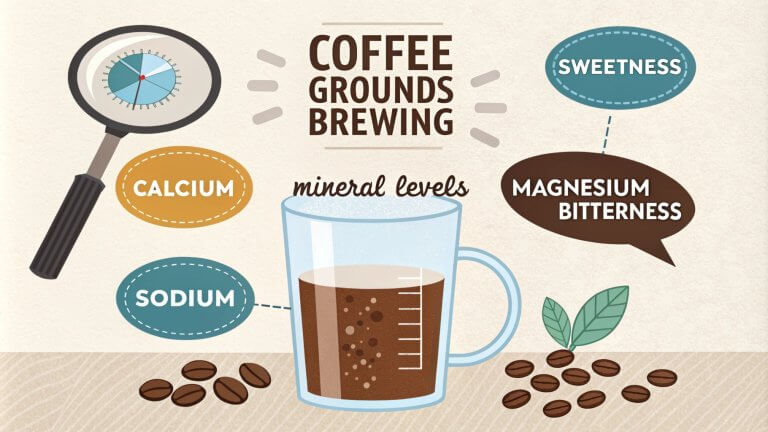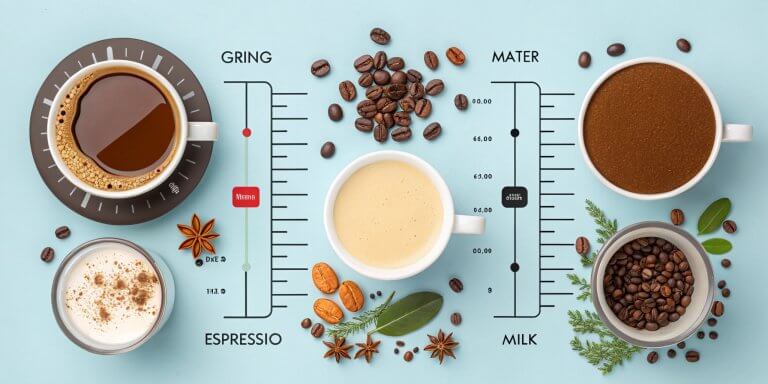
Imagine savoring a cup of coffee as dark as night, with a bold flavor that leaves a lasting impression. That’s the allure of French roast coffee, a favorite among many coffee enthusiasts for its intense taste and rich aroma.
But what is French roast coffee exactly? It’s more than just your average cup of joe. This roasting style, one of the darkest roasts available, is known for its dark brown color and shiny, oily surface that develops during roasting. If you’re looking for a coffee that offers a unique, intense experience, French Roast might be precisely what you need. It’s a journey into the depths of coffee’s flavor and aroma, a bold and rich experience that will leave a lasting impression.
In this article, we’ll demystify what French roast coffee is – from its unique roasting process to its distinct flavors. We will also explore why it stands out among other types of roasts and how best to enjoy it. Get ready to discover:
- The history and origins of French roast coffee
- How it’s made, including bean selection and roasting stages
- The unique flavor profile that sets it apart
- Brewing tips to make the perfect cup
So grab your favorite mug and prepare for an enlightening journey into French roast coffee!
What is French roast coffee?
So, what is French Roast coffee at its core? It’s essential to understand that French roast isn’t a particular coffee bean or from a specific origin. Instead, French roast defines a very dark roast style. French roast refers to a specific kind of process used on coffee beans.
This roasting style has deep European roots, and it gained popularity in the 19th century, quickly spreading across continents. Despite its name, it’s a common misconception that French roast is directly linked to France. The term “French Roast” is believed to have originated in Europe during the 19th century, when coffee roasting styles were often associated with different countries. This rich history and tradition are part of what makes French Roast coffee so special.
French Roast coffee beans are easily identifiable by their distinct appearance. The beans develop a shiny, oily surface and a deep, dark brown color.
You might also hear French roast referred to by other names. It’s sometimes called Turkish roast, Espresso roast, or Dark roast. Today, any high-roasted or dark bean can be labeled as “French Roast,” ” Espresso Roast or Dark Roast Coffee.
The Roasting Process Explained Step by Step
So, how does a coffee bean transform into a French Roast? It all comes down to a carefully controlled roasting process. Here’s a breakdown:
- Bean Selection: The journey begins with selecting the right beans. French Roasts are often made with 100% pure French Roast Coffee Beans. The beans can be Arabica, Robusta, or a blend of both. When shopping around for this variety of beans, look for ones labeled as 100% pure French Roast Coffee Beans; these will be noticeably darker than other roasted blends and have more robust flavors.
- Arabica beans are celebrated for their subtle flavors. They provide an excellent base for the smoky, caramelized taste synonymous with French roasts.
- Robusta beans can add body and caffeine content.
- Temperature: Next comes the heat. The beans are roasted at high temperatures. For French or dark roast coffee, the bean’s internal temperature should be close to 240 degrees Celsius (464 Fahrenheit) while roasting. The beans develop a shiny, oily surface and a deep, dark brown color at this stage.
- The Cracks: A key element in achieving the French Roast profile is the “second crack.” French roast coffee has an accumulation of oil visible on the exterior, caused by a process called the second crack. French roast coffee beans are at the end of the “second crack”. The beans are roasted until they crack twice.
- Cooling: Roasters rapidly cool the beans to halt the roasting process.
- DIY Roasting: Believe it or not, you can even try roasting your French Roast at home!.
The result? Beans are perfect for that bold, smoky cup of French roast coffee you’re after!
French Roast Coffee Flavor Profile
So, what does French Roast coffee taste like? Get ready for a sensory adventure! The flavor profile is smoky, bold, and intense, making it a favorite for those who love a potent brew.
- Tasting Notes: You’ll often find hints of chocolate, caramel, and sometimes even a charred note, adding to the complexity. French roast coffee beans offer a distinct charcoal-like flavour that some find sweet and smoky. French roast is a very dark roast that produces coffee beans with a rich, smoky, and bitter taste. French roast coffees are bittersweet, with a strong flavor almost solely from the bean’s roast profile.
- Acidity: Compared to lighter roasts, French Roast boasts low acidity. French roast coffee features prominent characteristics including boldness, bitterness, and low acidity.
- Body and Mouthfeel: The body is often described as thin, sometimes watery, yet still full-bodied. French roast coffee has an intense flavor, is smoky-sweet, and has a thin body, with a waterier mouthfeel.
- Factors that Affect Flavor: The beans’ unique characteristics. The distinctive flavors and roasting process tend to mask the unique characteristics of the beans. The unique flavors of the bean’s origin have been roasted away in the extended roasting process.
French Roast might be your perfect match if you appreciate a bold and distinctive coffee!
French roast compared to other roasts
Here’s a comparison of French Roast coffee with other roasts, based on your outline and the provided sources:
French roast is aark, but stands out more intensely than standard dark roast beans. While both are roasted at high temperatures sustainably, French roast beans undergo an even longer roasting time, resulting in a darker bean with a richer flavor.
Other roast styles include:
- Italian Roast: Italian roast is darker and oilier than French roast. It is usually considered the darkest roast.
- Spanish roast is darker than dark French roast.
- Lighter Roasts: French roasts differ significantly from lighter roasts like cinnamon or New England roasts, which are more acidic. French roast is far less acidic and more roasted in flavor compared to these lighter options.
Caffeine content in French roast coffee
French roast coffee typically has a lower caffeine content because of its longer roasting time. The extended roasting process breaks down some of the caffeine within the beans.
However, it’s important to note that bean type and brewing method can also affect caffeine levels.
- Arabica beans, which are often used for French roast, have slightly less caffeine than Robusta beans.
- The brewing method also plays a role.
Despite its bold and rich flavor, French roast coffee may not give you the caffeine kick you expect compared to lighter roasts. A light or medium roast might be a better choice if you’re looking for a caffeine jolt.
How to brew the perfect cup
To brew the perfect cup of French roast coffee, consider the following steps:
- Grind Size: Use a coarse grind using a French press. A medium-fine grind is more suitable for a pour-over.
- Water Temperature: The ideal water temperature should be between 195°F and 205°F.
- Brewing Methods: The best methods to highlight the flavor of French Roast are:
- French press: It extracts rich flavors and oils, emphasizing the coffee’s smoky notes. Allow the coffee to steep for about 4 minutes.
- Pour-over: enables precise control over brewing time and temperature, delivering a balanced and clean cup.
- Drip coffee maker: A drip coffee maker works well for French roast. Opt for a machine that maintains a brewing temperature of around 200°F. French roast beans are traditionally used for drip-brewed coffee.
- AeroPress: This provides a quick method for brewing a concentrated cup, highlighting chocolate and caramel notes.
- Coffee-to-Water Ratio: Aim for a coffee-to-water ratio between 1:15 and 1:18 to achieve optimal flavor extraction.
Health benefits and considerations
French roast coffee, like other coffee roasts, contains antioxidants. Additionally, dark roast coffee has the advantage of causing less irritation than other coffee roasts due to its lower acidity level, which is beneficial for folks who experience stomach acidity issues.
However, very dark roasts tend to be higher in acrylamide.
Moderation is key to any health benefits of coffee. Also, it is essential to check with a physician regarding concerns about how French roast coffee might affect an individual’s health.
Food pairings to enhance your experience
To enhance the experience of drinking French roast coffee, consider the following food pairings:
- Pairing Suggestions: French roast coffee pairs well with pastries, dark chocolate, cheese, or cured meats.
- Flavor Balance: These pairings complement the bold, smoky French roast. Bolder foods stand up well to French roast’s intense flavors. The rich taste of French roast coffee makes it suitable to pair with something sweet.
- Milk and Sugar: French roast coffee can be enjoyed with or without milk and sugar, depending on your preference.
Global variations and regional preferences
French roast coffee gained historical popularity in Europe, particularly in the 19th century, when darker, more intense flavors were favored. Today, coffee roasters employ the French roast process in Europe and many other regions. While the core roasting method remains consistent, some roasters may introduce regional twists or preparation methods to reflect local preferences.
Common Myths and Misconceptions
Here are some common myths and misconceptions about French roast coffee, drawing on the sources and our conversation history:
- Myth: French roast coffee is the strongest in caffeine. The level of caffeine in French roast coffee is substantially lower than that of its light roast counterparts. French roasts contain less caffeine than lighter roasts because the extended roasting process breaks down some of the caffeine within the beans.
- Myth: French roast coffee always tastes burnt. If it does, the beans may have been burned or left on a carafe burner too long. French roast coffee has a bold, intense flavor profile, but it should not taste only burned when roasted correctly.
- Misconception: The name “French” means the coffee is grown or roasted in France. The term “French” doesn’t necessarily denote any connection with France but instead describes the intensity of the roast. The French roast has the name of a particular regional method of roasting coffee.
- Misconception: French roast is not suitable for espresso. Dark roasts, French included, can pull decent espresso, but many coffee shops are incredibly picky about their espresso blends. French roast beans are traditionally used for drip-brewed coffee and make a nice, bold espresso.
Conclusion
In conclusion, French roast coffee is defined by its unique roasting process, where beans are roasted to the second crack to achieve a dark, glossy appearance and an intense flavor profile. It is characterized by its bold flavor, roasting process, and versatility. It offers a low-acidity option with a robust, slightly caramelized sweetness. A smoky, charred, and somewhat d characterizes its taste.
The French roast name refers to a roasting method in which coffee beans are heated until they reach a dark, near-charcoal hue. The name is now most associated with this method.
To find the perfect cup, explore different brands and brewing methods. Whether brewed at home or enjoyed in a café, French roast coffee provides a comforting, timeless experience.

